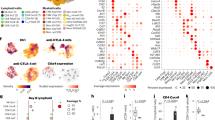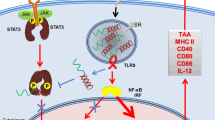Abstract
Previously, we found that dysfunctional natural killer (NK) cells with low interferon gamma (IFN-γ) were restored in acute myeloid leukemia (AML) by the FLT4 antagonist MAZ51. Here, we developed 12 peptides targeting FLT4 for clinical application and examined whether they restored the frequency of lymphocytes, especially T cells and NK cells, and high IFN-γ expression, as MAZ51 treatment did in our previous study. Although clinical data from using peptides are currently available, peptides targeting FLT4 to modulate immune cells have not been fully elucidated. In this study, we focus on novel peptide 4 (P4) from the intracellular domain of FLT4 because it had dominant negative activity. Similar to MAZ51, high IFN-γ levels were expressed in AML-mononuclear cells exposed to P4. Additionally, T and NK cell levels were restored, as were high IFN-γ levels, in a leukemic environment when P4 was treated. Interestingly, the regulatory T cells were significantly decreased by P4, implying the role of peptide in tumor niche. Overall, we demonstrated the therapeutic value of functionally modulating lymphocytes using a peptide targeting FLT4 and proposed the development of advanced therapeutic approaches against AML by using immune cells.



Similar content being viewed by others
References
Chen SJ, Shen Y, Chen Z (2013) A panoramic view of acute myeloid leukemia. Nat Genet 45(6):586–587
Wu D, Gao Y, Qi Y et al (2014) Peptide-based cancer therapy: opportunity and challenge. Cancer Lett 351(1):13–22
Baxter AA, Lay FT, Poon IKH et al (2017) Tumor cell membrane-targeting cationic antimicrobial peptides: novel insights into mechanisms of action and therapeutic prospects. Cell Mol Life Sci 74(20):3809–3825
Leppanen VM, Tvorogov D, Kisko K et al (2013) Structural and mechanistic insights into VEGF receptor 3 ligand binding and activation. Proc Natl Acad Sci U S A 110(32):12960–12965
Park S, Kim HJ, Hwang HS et al (2021) Peptides targeting FMS-related tyrosine kinase-4 activate the function of natural killer cells in acute myeloid Leukemia. Int J Stem Cells 14(4):400–409
Pizzolo G, Trentin L, Vinante F et al (1988) Natural killer cell function and lymphoid subpopulations in acute non-lymphoblastic leukaemia in complete remission. Br J Cancer 58(3):368–372
Lee JY, Park S, Kim DC et al (2013) A VEGFR-3 antagonist increases IFN-gamma expression on low functioning NK cells in acute myeloid leukemia. J Clin Immunol 33(4):826–837
Lee JY, Park S, Min WS et al (2014) Restoration of natural killer cell cytotoxicity by VEGFR-3 inhibition in myelogenous leukemia. Cancer Lett 354(2):281–289
Lee JY, Kim HJ (2014) (Lymph)angiogenic influences on hematopoietic cells in acute myeloid leukemia. Exp Mol Med 46:e122
Terren I, Orrantia A, Vitalle J et al (2020) CFSE dilution to study human T and NK cell proliferation in vitro. Methods Enzymol 631:239–255
Choi YH, Lim EJ, Kim SW et al (2019) IL-27 enhances IL-15/IL-18-mediated activation of human natural killer cells. J Immunother Cancer 7(1):168
Waldmann TA (2006) The biology of interleukin-2 and interleukin-15: implications for cancer therapy and vaccine design. Nat Rev Immunol 6(8):595–601
Chang YW, Su CM, Su YH et al (2014) Novel peptides suppress VEGFR-3 activity and antagonize VEGFR-3-mediated oncogenic effects. Oncotarget 5(11):3823–3835
Herskowitz I (1987) Functional inactivation of genes by dominant negative mutations. Nature 329(6136):219–222
Dorrity MW, Queitsch C, Fields S (2019) High-throughput identification of dominant negative polypeptides in yeast. Nat Methods 16(5):413–416
Kirkin V, Thiele W, Baumann P et al (2004) MAZ51, an indolinone that inhibits endothelial cell and tumor cell growth in vitro, suppresses tumor growth in vivo. Int J Cancer 112(6):986–993
Nishikawa H, Kato T, Tawara I et al (2005) IFN-gamma controls the generation/activation of CD4+CD25+ regulatory T cells in antitumor immune response. J Immunol 175(7):4433–4440
Funding
This work was financially supported by a grant from the National Research Foundation (NRF, 2018R1D1A1A09083557), Ministry of Education, Republic of Korea.
Author information
Authors and Affiliations
Contributions
JY Lee, S Park, AR Han, and HS Hwang performed the experiments and analyzed the data. JY Lee and HJ Kim wrote the manuscripts.
Corresponding author
Ethics declarations
Conflict of interest
The authors declare no conflicts of interest.
Ethics approval and consent to participate
All experiments were performed with authorization from the Institutional Review Board for Human Research at the Catholic University of Korea (KC19TESI0462). The patients/participants provided their written informed consent to participate in this study. All protocols for testing the animals were approved by the Catholic University of Korea's Institutional Animal Care and Use Committee (CUMC-2019-0135-01).
Additional information
Publisher's Note
Springer Nature remains neutral with regard to jurisdictional claims in published maps and institutional affiliations.
Rights and permissions
Springer Nature or its licensor (e.g. a society or other partner) holds exclusive rights to this article under a publishing agreement with the author(s) or other rightsholder(s); author self-archiving of the accepted manuscript version of this article is solely governed by the terms of such publishing agreement and applicable law.
About this article
Cite this article
Lee, J.Y., Park, S., Han, AR. et al. Therapeutic potential of FLT4-targeting peptide in acute myeloid leukemia. Cancer Immunol Immunother 72, 2919–2925 (2023). https://doi.org/10.1007/s00262-023-03385-8
Received:
Accepted:
Published:
Issue Date:
DOI: https://doi.org/10.1007/s00262-023-03385-8




